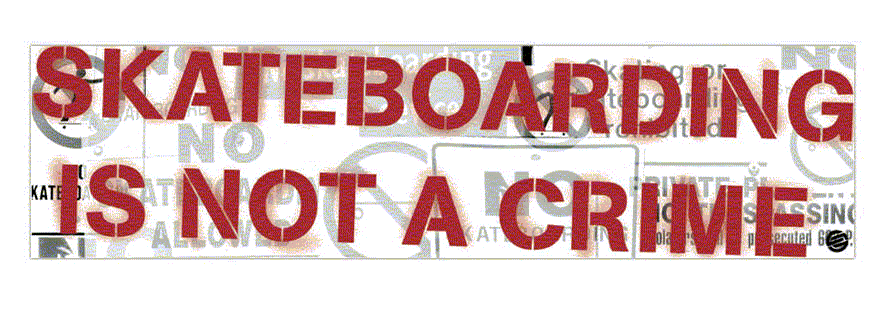
and I am trying to do something to further the cause!
Skateboarding in Mountain View, CA.
Shoreline Park and Stevens Creek Trails
If you like this site, click the +1 button to let your friends
find it easier...
Thanks to all the folks who have signed the petition. With your support, we've won!.
Contents:
- Time line / Status Updates
- Background information
- Eco-friendly skateboarding?
- Tips for fighting anti-skateboard regulations
- Contact information
Time line / Status Updates:
- 28.October.2019:
- Awaiting results of trial study period...
- AUG.2015:
-
Parks and Recreation Dept. and Mt. View city council approved a 1 year
trial period to allow skateboards on the SHoreline and Stevens Creek
multi-use trails:
- - http://www.mountainview.goc/depts/cs/parks/trails/default.asp
- Let's all skate safe on these trails and be respectful of the other trail users to ensure an uneventful trial period and hopefully in Aug. 2016 we'll be given permanent access!
- - http://www.mountainview.goc/depts/cs/parks/trails/default.asp
- 08.OCT.2014:
-
The Mountain View Parks and Recreation Commission will be reviewed
policies related to trails in city parks, including skateboard use at
their meeting. There is some good news to report. They did vote to
accept the staff review to implement a one year trial period for
"multi-modal" trail use. Multi-modal use includes skateboards
as well as e-bicycles and other motorized devices. Included in the
review of trail policies was a recommended city wide trail speed limit.
The commission pushed back to the parks and recreation staff to prodive
more details and options on speed limits. So we are on hold until that
further review is conducted. Assuming that moves forward without issues
(every trail system I have been on has a 15MPH speed limit), then the
commission will report to the city council some time in 2015 to
recommend beginning the one year trial period. Will need to find out if
the "multi-modal" trial period will be an "all or
nothing" deal or if separate modes of trail use will be subject to
separate acceptance. For example, I could see a gang of kids on
motorized scooters hitting the trails and harassing trail users. This
would garner a large number of complaints and we need to find out if
this would jeopardize skateboarding or not. Also need to find out what
the proposed reporting system is. This was done in the early '90s for
roller skating use on the trails, so likely whatever they did back
then, bit I never recall seeing anything back then when I used to use
the trail for lunch time walks where I used to work. But the big thing
will be to find out if it is a proportion of positive to negative
comments or only a certain number of negative comments. If the former,
we'll need to be sure to get every long distance rider who uses the
trail to fill out a card (or two:) with a positive comment every time
they ride.
- 13.NOV.2013:
-
So this meeting seemed to go fairly well. It seems that the commission
agrees that the differing regulations from city to city is
inconsistent. Also, it seems nobody knows why there is an existing ban
on skateboards. Likely if nothing can get dredged up from some old
paper file, the commission is somewhat in line with wiping that silly
rule from the books. I was able to trace it back to ~1992 when it seems
their electronic records system stops. So unless some "smoking
gun" is found in some old file drawer, it is looking good going
forward. And the park manager I have been e-mailing has found similar
results to my research, so while via e-mail, he is somewhat neutral, in
person he is kind of on "our" side.
- One bright light is that the commission chairman (Roger Burney) is a skateboarder from the late '60s, so is at least sympathetic to the cause! Anyone in the area know Roger at all? Looks like his term runs through the end of next year, so hopefully we can get this wrapped up in 2014.
- So, the commission voted unanimously to direct the city staff to look into the hows and whys of the current regulations and what it might take to change them. That work may happen by this following spring.
- One fly in the ointment is what were are also lumped in with electric bikes (pedal assist and other versions). So hopefully they can at least separate out the skateboard issue and decide on that fairly quickly as I think the e-bike thing could take years to sort out as there are some pending national and state regulations that will probably need to be in place before cities will want to adopt their own regulations.
- One bright light is that the commission chairman (Roger Burney) is a skateboarder from the late '60s, so is at least sympathetic to the cause! Anyone in the area know Roger at all? Looks like his term runs through the end of next year, so hopefully we can get this wrapped up in 2014.
- 19.SEP.2013:
-
Heard back from the city that this issue will be up for discussion at
the November Parks and Recreation Commission meeting.
- 19.JUN.2013:
-
Contacted the Parks Department to request an ipdate on this issue.
- 23.January.2013:
-
Received a reply to my inquiry of the 16th: "Parks Department
staff will be forwarding a formal request to have this item reviewed by
the Parks and Recreation Commission at a future meeting, the hope is to
have this item on an agenda this spring (2013)." Apparently this
is a new city policy that basically negated the Parks and Recreation
Commission voting to add this item to a future meeting agenda as was
done last spring. Oh well, as they say, "Two steps forward, one
step back".
- So this is an interesting move on the city's part in regards to further moving away from acting on issues brought up by citizens.
- 1. Initially it seemed that city staff could request the agendization of an issue that was brought to their attention (like when I first contacted the city about this issue).
- 2. Then it changed to a member of the public could bring up an issue at a committee meeting during the public input portion of the meeting. No discussion could take place then (no questions, no feedback, just talk for 3 minutes and sit down). But if you asked for an item to be added to a future meeting agenda, that committee could discuss and vote upon that request at a future meeting and if the vote was favorable, the committee directed city staff to research the issue and upon completion of that research, report back to the committee. At that time the issue would be added to an upcoming agenda and it could be discussed.
- 3. Now it seems that all the committee can do is vote to request that city staff make a request for the committee to add the item to a future meeting agenda. So it seems like this is just an additional step that must happen, perhaps the committees were doing too much on their own and the city felt they were losing control. This way the committees can't act on anything unless the sity staff tells them to act on it.
- So this is an interesting move on the city's part in regards to further moving away from acting on issues brought up by citizens.
- 16.January.2013:
-
Asked city parks dept. for an update on the status of the ongoing
research into this issue as it has been over 6 months of hearing
nothing. No reply to date.
- 03.January.2013:
-
If you have signed the petition
and want to send your comments directly to the city, feel free to
submit a question to the city Parks Dept. via the Ask
Mountain View service - click on the Ask Mountain View
link. Select "Shoreline/Golf" or "Parks,
Trees and Trails" and then "Stevens Creek Trails"
then click the "Next" button and fill in contact
information the click "Next" and add your comments
about how the current skateboarding ban on the Shoreline and Stevens
Creek trails affect you. Let them know that responsible long boarding
is a safe activity and is eco-friendly and is compatible with the
existing trail users. Let's hit the city with hundreds of requests and
comments and let them know that this is an activity that they should
allow on their trails just like all the other surrounding cities do.
- 04.October.2012:
- Provided additional information to the city parks dept. contact regarding skateboarding regulations in other cities (Sumner, WA., Seattle, WA., Portland, OR. Saskatoon, Canada). Heard no reply in response to this information submission.
- 04.July.2012:
-
AVS Gear picked up on the skateboard ban fight:
- http://www.axsgear.com/blog/featured-longboard-business-news/engineer-55-seeks-to-change-citys-skateboarding-ban-on-trails/
- http://www.axsgear.com/blog/featured-longboard-business-news/engineer-55-seeks-to-change-citys-skateboarding-ban-on-trails/
- 13.June.2012:
- The city Parks and Recreation Commission has voted (5 - 0) to add this item on a future commission meeting agenda once city staff completes a study of the current ordinance.
- 29.May.2012:
-
Had an interview and photo shoot with the local Mountain View Voice
newspaper:
- http://www.mv-voice.com/news/show_story.php?id=5673
- Also created a QR Code link for the petition so it is easy to scan with a smart phone or tablet camera. Feel free to download and print the QR Code and/or petition and post it in your local skateboard hangout.
- http://www.mv-voice.com/news/show_story.php?id=5673
- 23.May.2012:
-
To date, I have attended a Mountain View city council meeting (5/22/12)
and a Mountain View Parks and Recreation Committee meeting (5/23/12) to
get this issue added to an upcoming meeting agenda. At these initial
meetings, you do not get anything in the way of feedback as California
state law prohibits and action being taken upon issues brought up in
the public comment sections of any official meeting. So you basically
get 3 minutes to address your issue and that is it, no questions, no
comments, nothing.
- Here are my notes for the city council and PRC meetings.
- Anyway, now it is a waiting game. In talking to a few city contacts, it seems that the process to get this issue added to some committee's agenda may take a while. With the initial city council meeting, it was recommended that I take the issue to the Parks and Rec. Committee (PRC), since the issue is related to a park. But then, it seems that since the issue has to do with a trail (i.e. transportation), the PRC will likely hand it back to the city council. Then the city council will convene a meeting of the City Transportation Committee (CTC), since the CTC only meets at the request of the council. Then since this issue has to do with a "biking/hiking" trail and not a road, the CTC will likely send the issue to the city Bicycle/Pedestrian Access Committee (B/PAC). Since the B/PAC can only take on issues sent in from the CTC, I have to wait until this point before addressing the B/PAC. Hopefully, there will be many hundreds of signatures at this time to bring to the B/PAC meeting. Also, if anyone local, especially Mountain View residents would like to attend this meeting, please contact me.
- 27.January.2012:
-
While skating on the paved Bay Trail segment through Shoreline Park,
pulled over to let a park ranger in a golf cart go by. Instead of
passing me, he stopped and told me to follow him to the main park
picnic area. There in a small bulletin board was a sheet of paper with
20 or so park rules including the aforementioned "Skateboards are
Prohibited in Shoreline Park". Luckily the ranger was cool about
it and did not confiscate my board and he did allow me to finish my
ride which is good because I was a good 5 miles from my vehicle and
that would have been a LONG WALK back. As the rule it written, mere
possession of a skateboard within the park boundaries seems to be
banned, so if the ranger was not so cool, he could have taken my board
and made me walk the 5 miles back to my vehicle.
After returning home, I posted a question regarding this issue on the Mountain View "Ask the City" web page and was ultimately put into contact with the city Parks Department. - 28.September-2011 - 26.January.2012:
- Time period over which I was doing long distance skateboarding on the Bay Trail at Shoreline Park and the Stevens Creek and Hetch Hetchy trails in Mt. View without any issues with other trail users. Had numerous questions and positive comments about how to pump a board, etc. I've ridden well over 130 miles on these paved multi-use trails and not once encountered any negative comments from other trail users.
- 09.SEP.2011:
- First ride on the long distance board after building a new board with modern trucks, wheels and wedging. Wow, what a difference to the old days back in college with stiff boards and trucks and rock hard, small diameter wheels. First ride went out and rode nearly 5 miles, I was totally spent after that but it was so much fun that I was hooked. I rode about 465 miles the rest of the year and now 1500 miles the following year.
Skateboarding on the Bay Trail at Shoreline Park
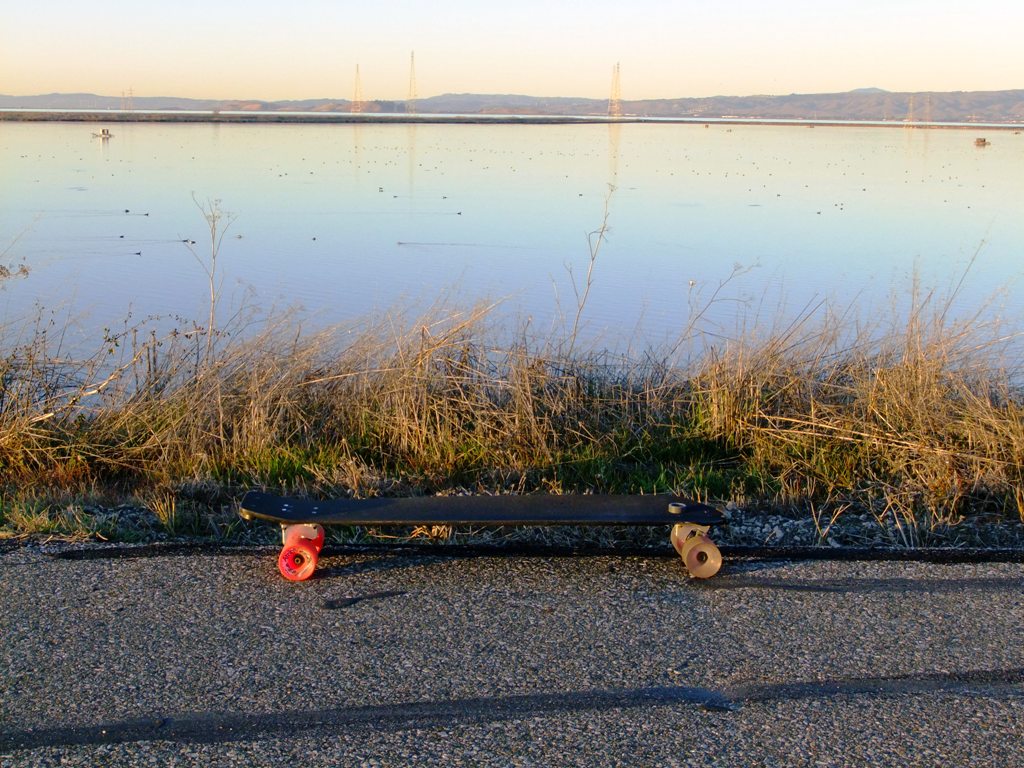 |
| Long Distance riding at Shoreline Park on the SF Bay Trail |
Background:
For folks not familiar with long distance skateboarding, see the web page and video below for more information:
Paved Wave web site - Long distance skateboarding resource
Typical long distance skateboard riding - pumping example
Realize that most forms of skateboarding are illegal to some degree in most areas around where I live. You generally can't ride on the streets, you can't ride in downtown business areas on sidewalks, or parking garages, school property, etc. So it seems that most skateboarders are resigned to the fact that to enjoy their sport, they must break the law to do so. So they find a deserted hilly street and bomb the downhill with someone on lookout for traffic or law enforcement. Or they sneak into a parking garage at night and do the same or find an empty private pool to skate in, etc.
However, long distance skateboarding (pushing, pumping, paddling) is a real paradigm shift as far as legality goes. With many cities in the US embarking on developing an ever expanding network of MULTIPLE- USE TRAILS (MUT), on which most any form of non-motorized access is allowed, this makes a perfect, legal venue for skateboard riding. Just think, you can ride any time and not have to worry about looking over your shoulder for the "fuzz" or having to arrange for lookouts and get-away cars, etc. You can just go out and ride and ride and ride and it is encouraged. Well, most places, except for Mountain View, CA. For some unknown reason, their multi-use trails are not as "multi-use" as other cities, at least for the time being.
Now, in my younger days, I rode downhill and did slides and rode empty pools and skate parks and hung out at various places grinding and riding steps and all that stuff. I kind of lost interest in that sort of riding over the years as it became less and less accepted and with time, the body does not respond to the falls and abuse that sort of riding does to you. But then I rediscovered long distance riding and it is way more fun than dinking around for hours on some steps or trying to grind some curb or master some slide or trick. Back in the day, it used to be about 2 miles ride for me across town to the local college campus where I went to school and where most of the good skate spots were, and a 2 mile ride back. What I found after rediscovering long distance boarding is that it was actually the 2 mile ride across town that was really what I liked as a kid, more so now with modern equipment set up for long distance riding.
So you might be reading this and saying long distance riding looks "gay" or must be boring or whatever. I say, don't knock it until you have tried it. It is really fun and it is one heck of an aerobic workout, I burn about 20% more calories per hour on the skateboard than on a hard bike ride and have a blast doing it to boot. There is a real magical feeling of linking together a couple of miles of pumping without touching a foot to the ground. And where else can you ride a skateboard for mile after mile without stopping. Riding a downhill might give you a minute of riding down then a 10 minute hike back to the top, or in a skate park, you might get 30 seconds or a minute long ride before you miss a turn or fall or whatever. With long distance pushing or pumping or stand up paddling, you can go out and ride a marathon distance if you want, and I have done this from the front door of my house. And I can ride like that any day of the year and it is both free of cost and totally legal on many of the city MUT paths in my area. I would encourage anybody that has ever skateboarded in the past to give it a try. You can visit http://www.pavedwave.org/ to get pointers to equipment and setup for long distance riding. I find that it is being on a skateboard that is the fun part, not so much what you are doing while on the board. And if you can get some exercise while riding, all the better.
And you might ask if I have so many trails to skate on, why bother about Mountain View? Well, I don't live there, I live a few towns away. Hard to see in the photo above, but the trails at Shoreline Park and Stevens Creek are really beautiful. At Shoreline, you are skating right on San Francisco Bay, with waves lapping against edge of the trail and shorebirds all around. So not only are you having a blast riding a skateboard and getting an awesome workout, but you are doing both in a gorgeous setting with fresh air, away from traffic and crowds. Many of the trails I ride closer to home run along side busy roads or highways or behind parking lots, etc. Nothing like riding along trying to get some exercise when you are 10 feet away from 6 lanes of stop and go traffic belching out exhaust!
And many skate boarders reading this may say, "who cares", I am a downhill rider or I like to do sliding, or ride the ramps and bowls or grind railings and curbs and there is none of that kind of riding out in Mountain View. To that I say, skateboarding is skateboarding. If it is a piece of wood with two trucks and 4 wheels it is a skateboard. It should not matter what sort of riding you (or I) do, we are all skateboarders. And while you may not now be into long distance riding, some way you might be. Or as some of the comments on the petition page mention, what happens if you take your kids out to Shoreline Park some weekend. The kids want to ride their new scooters or bike or whatever and you decide to drag out your old skateboard and cruise along with them. All is fine until you encounter "Ranger Rick" and he stops you, confiscates your board and ruins what was to be a fun day with your kids at the park. And one of the strategies being used in this fight is to show this city that surrounding cities allow skateboards on their MUTs, so they should follow suit and adopt similar rules. However, that strategy could be used against skateboard use by a neighboring city seeing that Mt. View bans skateboards "so maybe we should do the same". So you either have to fight to expand legalizing skateboarding (in all forms) or you let it become more and more illegal. Now while I may not currently ride downhill or do sliding or tricks or ride skate parks, I support your right to do so and I would be more than happy to sign your petition to allow your form of skateboarding to continue.
Here is the actual park regulation page that is printed out (on 8.5"x11" sheet of paper) in the bulletin board inside Shoreline Park:
It seems that mere possession of a skateboard is a crime, on the same level as a firearm or other weapon:
11. Skateboards are prohibited. (Section 38.20g)
13. Firearms or any other dangerous weapons are prohibited. (Section 38.13h)
That is the first time I have heard of a skateboard being classified as a dangerous weapon! And this is even better:
20. "Kite buggies"/wind propelled vehicles are allowed. (Section 38.13f)
What is a kite buggy, you might ask?
So I can take one of these things out on the flat, wide open multi-use trail and yet my skateboard riding is prohibited??? Interestingly, kite buggy folks often use a "mountain board" (which is a skateboard set up for off-pavement use with larger air filled tires) with a kite and stand on it instead of sitting down as on a kite buggy. So apparently I can take my skateboard along with a kite and legally ride the trails since that is a "kite buggy", yet without the kite, it is illegal? If someone can explain that one to me, I am all ears!
But wait, there is more! Yes, I can also go buy a 120 lb. battery powered Segway and rider that on these very same trails! This mode of transportation was allowed on the Mt. View trails after a potential Segway commuter asked about gaining access. This sort of goes against the "no motorized vehicles" aspect of the multi-use trails, but was allowed in under the possibility that it is a valid form of transportation for the disabled, similar to a motorized wheel chair. The city produced a monumental 319 pg. document on all the research they did for this issue, feel free to have a look.
Here is a California statute covering "Skateboarding" that may apply:
Under "Existing Law":
4) Defines skateboarding as a "hazardous recreational activity" if the person skateboarding is at least 12 years old, the skateboarding activity causing injury as a stunt, trick, or street-luge skateboarding, and the injury occurred on public property requiring a helmet, elbow pads, and knee pads. Existing law also mandates that no operator of a skateboard park permit a person to skateboard within that park, unless that person wears a helmet, elbow pads, and knee pads. (Health & Safety Code Section 115800.)
It seems all that is required for state liability requirements is that specific language regarding skateboarding be posted on the trails. That is requiring a helmet, elbow and knee pads for use of a skateboard use in the area. How this would be different than the city permitting skateboard use, unsigned and unregulated, upon it's sidewalks is puzzling. In fact in many places, I can skateboard legally down a Mountain View city sidewalk to a trail access point for the trails in question bit at some point that city sidewalk becomes a city multi-use trail and suddenly I can't continue on?
In terms of rider safety, the excellent quality of the multi-use trails makes them far safer to ride than the city mandated sidewalks.
- There are no cracks or expansion joints on the multi-use trails like on sidewalks.
- There is much less debris on the trails, the trails are wider.
- There is no cross traffic such as cars pulling into and out of driveways.
-
There are no dangerous sidewalks with automobile traffic not obeying
pedestrian right of way and running stop signs and red lights.
- And I have been hit by an automobile in a traffic light controlled crosswalk, so I know about this!!!
- There is much more inattentive pedestrian traffic on city sidewalks, children and pets that can run suddenly out of a yard without looking, etc.
So the city is forcing people to ride on the inherently more dangerous sidewalks than on the much safer multi-use trails which were designed for multiple uses of both foot and wheeled traffic. There is no issue with requiring proper rider protection, like helmet, wrist protection, elbow and knee pads. That is a good idea and is something that any responsible long distance skateboarder does anyway.
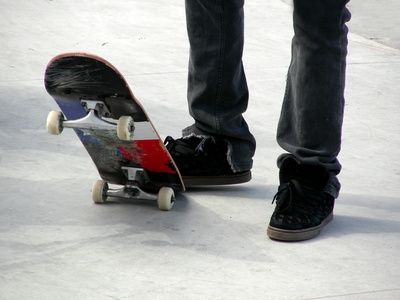 |
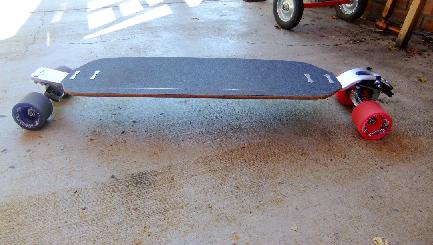 |
| Trick or stunt skateboard | Long distance skateboard |
In long distance skateboarding, there are no stunts or tricks involved. The whole point of the activity is to go from point A to point B in as efficient manner as possible. As such, the equipment is designed for forward locomotion and not for doing stunts or tricks. In fact, long distance boards often lack functional kick tails which are typically used for performing spinning tricks. Also they are relatively heavy (8 - 10 lbs) and that precludes the tricks involving flipping the board up. Likewise, they feature asymmetric trucks such that it is not practical to ride these boards backwards, so the "fakie" tricks that involve riding up a ramp in the forward direction then reversing and riding down the ramp backwards is not possible to do. And long distance skateboards feature large, high traction wheels upon which is is not possible, nor desirable, to be able to slide. Sliding these sorts of wheels will damage them (at a cost of $60-100/set) and sliding means wasted energy and that goes against the efficient means of getting from point A to point B aspect of the activity. All these aspects of a skateboard designed for long distance riding make it not suited to performing stunts or tricks.
It is the same thing as comparing your road bike with multiple gears, drop handle bars and clip-less pedals to the free-style stunt bicycle your child rides with the fixed gear, no brakes and foot pegs front and rear. Sure both are bicycles but one is designed for riding scores of miles on the road and one is designed for performing stunts and tricks. While both are bicycles, you would not take your child's stunt bike out to participate in a century ride (100 miles) such as the Sequoia Century, nor would you take your multi-speed road bike out to do bar spins and wheelies and all those tricks and stunts that the kids do these days. The same is true of taking a skateboard designed for performing stunts and tricks out onto a miles long multi-use trail. The small, hard wheels and stiff, bone-jarring ride would leave your feet numb in short order and you would end up carrying the board. I observe this frequently on other multi-use trails I ride my skateboard upon.
Stunt riding is possible in most any form of sport, it is human nature. Give one person a bicycle and they will go out and try to see how far or high they can jump it or how far they can ride a wheelie, etc. Give a bicycle to another person and they will go out and see how long a distance they can ride with it. Same is also true for roller skates, inline skates and skateboards as you can see below:
| Sport/Discipline | Stunt Riding | Distance Riding |
| Cycling | 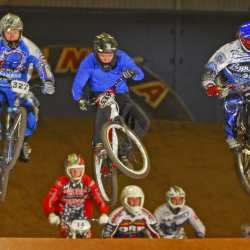 |
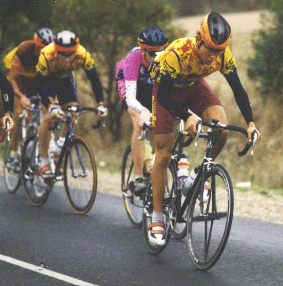 |
| Roller Skating | 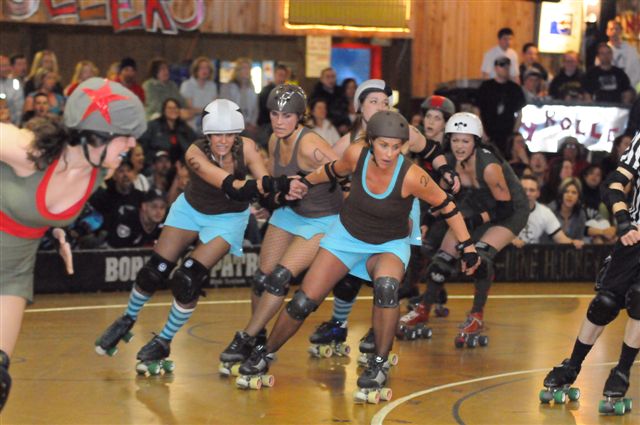 |
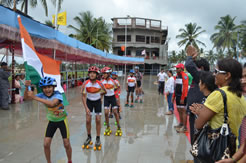 |
| Inline Skating | 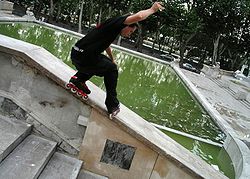 |
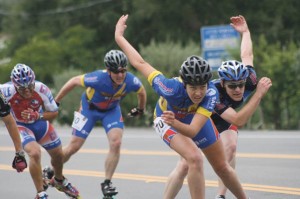 |
| Skateboarding | 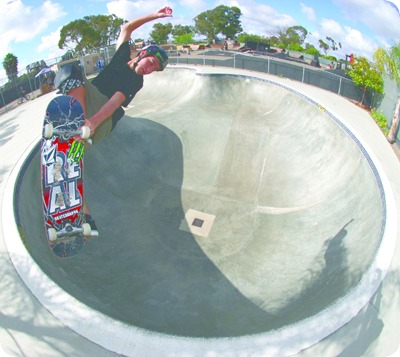 |
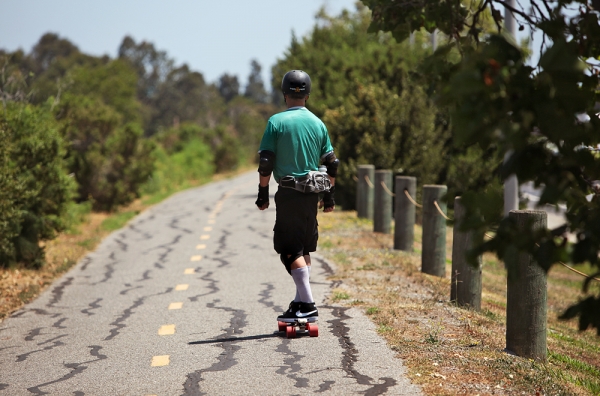 |
Stunt riding is not something that would be appropriate on the trails in question, in any form, skateboards, roller or in-line skates, scooters, bicycles, etc. So the more logical approach to trail usage would be to ban classes of activities that are not desirable on the multi-use trails. That would be all forms of unsafe stunt riding, no matter what mode of transportation is involved. For example, bicycles are allowed without restriction on the trail, but look what can be done on a road bicycle! And all forms of activities that would cause damage to the trail, city property and the surrounding area. For example, this is already in place now with no travel off of the paved paths. And finally, the best deterrent to stunt riding is to maintain the current trail design so that is does not include features conducive to stunt riding.
In fact, the reason that there are not hoardes of skateboard riders out there today is likely not because it is not permitted, rather because the terrain out there is not conducive to that form of skateboarding. There are no curbs or ramps or railings nor any large open flat areas where tricks or stunts could be performed. I can assure you that, for example, if there were an empty swimming pool behind the Old Rengstorff House, you can have electrified razor wire fences and 24/7 armed guards and you would have skateboarders all over the place. So the greatest deterrent to trick and stunt riding is lack of any "interesting" terrain or features. In years gone by, I used to do such stunt skateboard riding and developed an "eye" towards locating "skate-able terrain" and in all my exploring around Shoreline and Stevens Creek trails, I have found nothing that would be worth the effort to take a board out to try and ride, even if it were legal.
In this aspect, long distance skateboarding is no different that roller or in-line skating or scooters, as practiced on these very trails. You can perform stunts and tricks on roller or in-line skates or scooters. In fact you can take those types of skates or scooters to many skate parks and ride the same bowls and ramps that you can ride a skateboard on and do the same stunts and tricks. Likewise, you can take those same roller or in-line skates or scooters out on a flat paved trail and travel from point A to point B. Same thing on a bicycle, why not the same rules for a skateboard?
As another comparison, you might consider snow boarding and cross country skiing. Both involve riding on a device over snow. In snow boarding, tricks and stunts are a common form of activity. A popular quote from a snow board instructor would be "If you're not falling down, you're not trying hard enough.". In cross country skiing, the goal of the activity is to move efficiently from point A to point B using the person's power and technique to propel themselves over the snow. Doing tricks and stunts on cross country skis is not very easy to do nor is it even a goal of the activity. Being an avid cross country skier myself, having skied over 100km in a single day, I can assure you that you want all your energy going towards moving you forward across the snow and not trying to do tricks on these skinny, edge-less skis. And in this type of skiing, falling is not a common thing to do, it is not desirable at all and falling is not a way to learn proper technique.
There are many negative aspects of this skateboarding ban:
-
Alienating the young riders in the city: Can't ride in the parks, can
only ride legally in the one city skate park.
- There are more aspects to skateboarding that just riding in a skate park.
- Make riders have to make a decision whether to break the law to ride or not.
- Older riders are coming back to the sport for the exercise benefits on long distance riding
- The ban makes skateboarders feel like second class citizens because they are not welcome anywhere in the city outside the skate park
When riding skateboards on flat pavement, far and away the most common cause of a rider falling is due to the skateboard wheels encountering debris or an obstruction too high to roll over, causing the board to stop and the rider to continue forward. Assuming Newton's First Law of Motion applies in Mountain View, CA., a body at rest will remain at rest unless acted on by an external force. It has been my experience and the experience of a number of long distance skateboard riders that I have polled, that this is how all their falls have transpired.
What really happens to a skateboard when a long distance rider falls?
In flat land, distance skating, falls are a very rare occurrence with modern equipment and techniques. I used to ride a lot in the late '70s - early '80s and falling was common place. But since resuming the sport over a year ago, I have clocked over 1500 miles and have fallen exactly five times. The first four times due to the board stopping and me not. Two of those falls were within my first 100 miles of riding and due to errors in technique and the other two times were due to hitting debris or irregularities on city sidewalks. The 5th fall was when a car hit me in a light-controlled crosswalk (I had the walk light in my direction and the car ran the red light and violated the limit line on the crosswalk and hit me within the marked crosswalk. I tucked and rolled when the car hit me and with the full padding I wear, suffered no injury. In fact, being forced to skate on the city sidewalks and navigate crosswalks is far more dangerous that skating on a dedicated multi-use trail where there is no automobile traffic, no stop lights, no crosswalks, etc. So why does the city banish it's skateboarding population to the dangerous sidewalks and not allow them on the far safer trails purpose-built to be safe places for people to travel and exercise on? Again, in all cases, board stopped, momentum carried me, the rider forward and off the board, causing me to fall and the board was still sitting right where it stopped. With elbow and knee pads, wrist guards and a helmet, I had no injuries from any of my falls and continued to skate after returning to the board that was sitting right where it had stopped.
And in case you don't believe that a skateboard stops and rider continues on to fall, check out the following video at about 0:05 and in slow motion at 0:19 and you'll see visible proof:
And in case you think that is a fluke, here is another fall at about the 2:00 mark:
Once again, Sir Isaac Newton is proved correct again; board stops, rider loses contact with board and the board remains STOPPED! In this case the board flipped upside down so of course it will not go anyplace, but that it what happens quite often depending on what stopped the board. But, in a case where a board might continue rolling, like on a slight grade, you can mathematically and statisticallyt analyze what happens to the board. A typical bike path is 10-12' wide, so the on average, the board would be no farther than 6' from the edge of the trail. And given that the rider can lose contact with the board with it facing anywhere from 0° to 90° with respect to the direction of the trail. So with the board at 45° or more angle to the direction of the trail, it will only roll less than 6' before leaving the paved trail and stopping in the dirt or grass off the side. And even at a small 9° angle, the board could roll no more than 38' before leaving the trail surface. So assuming an equal distribution of board-trail angles, in only 10% of cases could a board physically roll 38' or more before leaving the trail, assuming it somehow had the momentum to do so. In my trail riding I usually see about 0.1 mi. / 500' between groups of trail users, so it would only be about 1 in 13 chance (38/500) that another trail user would be within the 38' "rolling" distance which in turn can only happen in 1 in 10 (9/90) falls. And since in my riding experience, I have perhaps 1 fall in 500 miles of riding, you would be looking at 1 incidence of a fellow trail user being within rolling range of a board for every 65,000 miles of skateboard riding. So with about 5 miles of skateable trails at Shoreline Park, this would be 1 in 13,000 skateboard visits to the park. And realize that if a rider falls 30 some feet away from a pedestrian and a board slowly rolls away, that pedestrian would have many seconds to react to any situation. This would be no different than when young children are riding scooters or bicycles and veer out of their line of travel or fall into the path of an oncoming trail user. So in short, it just does not seem to be a valid concern that wildy careening, out of control skateboards will be flying willy nilly around Shoreline Park if they are allowed on the paved paths. Assuming that the city has not outlawed Newton's Laws of Motion, inanimate objects do not just get up and move on their own.
If most of your skateboard use experience has been watching kids practicing tricks in the school parking lot or at the skate park, or perhaps only from watching TV coverage of the Dew Tour or downhill/street luge skateboarding, then yes, boards and riders flying all over the place are common (falls are good for TV ratings).
That sort of equipment and riding technique does not work out on a long flat trail like at Shoreline Park.
Those type of boards have small, hard wheels and short decks that are ill-suited to pushing or pumping over long distances.
On the San Tomas Aquino Creek trail where I mainly ride, you rarely see such skateboards being ridden. More often than not they are being carried and not ridden.
I live 3 blocks from the Santa Clara skate park and I see lots of kids riding to/from the park on the sidewalks. By the time I go 2 more blocks away from the park, it is rare to see any boards being ridden, they are all being carried. On those types of boards, the average rider will stop riding after maybe 1/4 mile on sidewalks or pavement because it is too difficult and tiring.
Consistent regulations on the Bay Trail system:
Currently it is OK to skateboard on the San Jose, Santa Clara, Sunnyvale and Palo Alto segments of the Bay Trail.
But it is not OK to do so on the Mountain. View segment.
This fact is not properly signed at the city boundaries on the trail nor at any entrances to the trails from within the city of Mountain View. All these access points are directly adjacent to city sidewalks upon which it is perfectly legal to ride a skateboard. Yet, cross that invisible line at which point the legal city sidewalk turns into the illegal city multi-use path and you are braking the law without knowing unless you have researched on-line to find this obscure city ordinance.
Palo Alto:
- Park rules and regulations: http://www.cityofpaloalto.org/civica/filebank/blobdload.asp?BlobID=6048
R1-11. TENNIS COURT USAGE Any person or group using a City tennis court shall do so according to the following rules: A. No person shall operate, drive or ride a bicycle, unicycle, roller skates, roller blades, skateboard or other coasting device on City owned tennis courts.
R1-14. SKATEBOARD FACILITY ... H. No person shall cause a skateboard to shoot out away from their feet or body. ...
R1-18. BICYCLES, SKATEBOARDS AND ROLLER SKATES
A. Bicycles are prohibited on unpaved trails of Foothills Park. Skateboards, roller skates or blades, or other coasting devices are prohibited in Foothills Park.
B. Bicycles are prohibited on unpaved trails of open space parks and preserves, unless designated for bike access within the Pearson-Arastradero and Baylands Preserves. Skateboards, roller skates or blades, or other coasting devices are prohibited in open space parks and preserves, except on paved, multi-use bike paths.
C. Helmets: No person shall operate a bicycle or similar device on parks or open space preserves without wearing an A.N.S.I. or Snell-approved bicycle helmet for head protection. No parent or guardian shall allow any child under the age of 18 to ride a bicycle without a helmet.
D. Unsafe operation: No person shall operate a bicycle in a reckless or negligent manner so as to endanger public property, or the life, limb, or property of any person or animal. No person shall ride in or upon a portion of a bicycle not intended for passengers. No person shall operate a bicycle while wearing earphones that interfere with hearing ambient noise.
E. No person shall leave a bicycle, scooter or skateboard in any place or position where other persons may trip over or be injured by it.
Sunnyvale:
In-line skating and skateboarding are considered positive recreational pursuits; safe, courteous in-line skating and skateboarding are welcomed throughout the City of Sunnyvale park system.
Where can I in-line skate or skateboard? A few of the more popular in-line skating and skateboard areas are the multi-purpose concrete bowls located at Lakewood, Raynor, Serra and DeAnza Parks. Skateboarders and in-line skaters are also welcome on the hard-surface sidewalks and pathways throughout the park system so long as they do not pose a hazard to other forms of traffic such as pedestrians, bicyclists, or joggers. In-line skating is allowed in public park parking lots under the same condition.
Where can't I in-line skate and skateboard? Skateboarding is not allowed in any public parking lot, and it is illegal to skateboard or in-line skate on any tennis or basketball court maintained by the City (these surfaces are specially treated, are very costly to maintain, and are easily damaged by wheels). Skateboarding which damages public property (such as park benches, retaining walls, or play equipment) is prohibited, as is the waxing of public property to facilitate skateboarding. Waxing can create hazardous conditions for park visitors and is quite costly to remove. Lastly, in-line skating and skateboarding are prohibited on some school properties. Please obey any related signage.
San Jose:
If any city were to encounter issues with mixing traditional stunt and trick skateboard riding and multi-use trails, this would be the place. On the Coyote Creek multi-use Trail in San Jose, the trail skirts the outer edge of the Stonegate Skate Park without any surrounding fencing or warning signs. If having skateboards flying out of control and hitting trail users was a problem, there would be fencing and warning signs all over this place. But since there is nothing but the smooth concrete of the skate park transitioning into the asphalt pavement of the multi-use trail, apparently this conjunction is not an issue. As far as I can tell, San Jose has no mention of skateboarding restrictions on any of their multi-use trails, totaling about 100 miles:
- http://www.sjparks.org/Trails/TrailsRules.asp
The only skateboarding prohibitions seem to be the typical downtown business sidewalk section, on sidewalks in the Willow Glen area and in city owned buildings and parking garages.
Eco-friendly skateboarding:
You bet it is, especially the long distance disciplines like I am a proponent of. I run a home business and frequently need to run errands during the day to either pick up parts or supplies and to take the shipments for the day to the post office or UPS or other shipper. So when I can, I try to make those little trips by human power, either walking, or riding a bicycle or skateboard, depending on the weather, how much time I have and how much stuff I need to carry. So what does this add up to over a year, after all a couple of miles here or there not driving can't amount to a hill of beans, right? WRONG. Here are my actual GPS mileage totals and my actual vehicle odometer distance for calendar year 2012, you be the judge:
Driving: 1717 miles Walking: 187 miles Skating: 1467 miles Cycling: 1979 miles ------------------- Total: 3644 miles
I did over twice the miles under my own power than I drove last year. Now granted, not every one of the human-powered miles was related to eliminating a driving mile, but many were. And if you look at it, if I skate the 2.5 miles to/from the post office to drop off a load of packages, that adds 2.5 mi. to the skating balance and takes 2.5 mi. off the driving balance so that is a swing of 5 miles for one short trip. Those all add up over an entire year!
Now if you would rather I go back to driving 100% of those trips and burning all that gasoline and clogging the roads during rush hour, I will. But I think you would rather that I skate and enjoy.
Tips for fighting anti-skateboarding regulations:
It seems every anti-skateboarding regulation is likely to be unique in some aspect. So far I have found a couple of key points to look for in my fight.
-
First realize that the only way to get an anti-skateboarding law change
is to bring up an argument to change the law in front of the authority
responsible for creating that law. They will be the only ones that can
make a change to the law.
- So, find out who is in charge of setting (and hopefully changing) the regulations in the area that you want to skateboard on. If it is in a park, try the park commission (city, county, stake or whatever), if it is a city, try the city council, etc. Sometimes this can be complicated, as evidenced by this very rule fight. And also realize that where you start the battle is not where it may end. Again in this case, started with the parks commission and may end with the city bicycle/pedestrian access committee, since it is an issue on a bike trail but that trail is in a park.
-
Find out what the key reason(s) for the ban are. It is important to
identify what these reasons are and also what the mind set of the folks
who have set these regulations is. Many times these regulations have
been in place for many decades and it could be that the folks who put
the regulation in place are no longer in a position of power, you can
use this to your advantage in fighting the ban. Also, try to keep your
arguments focused on just these concerns and don't bring in other
topics to confuse the issue.
- And realize that the average person might only know skateboarding from clips on TV of some ramp or bowl skateboard contest or perhaps a downhill or street luge contest. All they know of the sport is high speed wipeouts or riders doing crazy tricks and wiping out. You need to educate them on the non-competitive aspects of the sport, how it is safe, controlled, environmentally friendly and can co-exist with other trail users.
- Related to this point is to find out what type of arguments the regulation setting folks are interested in, that is to listen/read carefully any responses or feedback you get. For example, out of my 3 minute presentation to the city council, the main note entered in my one line summary in the meeting minutes was that surrounding cities had no such ban. That tells me that this city is concerned with "fitting in" with what the surrounding cities are doing regarding skateboarding. So I plan to use this in future meetings and perhaps the city staff is also looking into skateboard regulations in surrounding cities on their own (I hope!).
- And keep the fight focused on just the one area instead of trying to take on too large a fight to start with. For example, in this case, I am only focusing on the multi-use trails in the city. I am not trying to take on allowing skateboards on downtown sidewalks or on-road bicycle lanes within the city. Maybe some day, but for now, just stick to the multi-use trails in the city.
-
Related to #1 is to get a "champion" (or two) inside the
organization you are working with to change the regulation. You need a
person or two on the inside that can help you navigate the various
levels of bureaucracy so you focus your efforts on the right group at
the right time. And having more than one contact can really help, as
one person may not "know it all". So in this very fight, I
was initially told to work with the B/PAC group, but later found out
that that group can't really do anything unless directed to do so from
a committee above them and that committee can't do anything unless
directed by the city council. So while it is true that the B/PAC may
ultimately be the folks to debate the ban and reverse it, you can't
start there. So a second "champion" can give a different
insight on the inner workings of the governing body you are working
with. And, most importantly, you need someone inside to tell you when
your topic will come up for discussion in a public meeting. Problem is
that once you present your case originally, it will disappear into the
bowels of that bureaucracy and some time down the road, it will pop up
in a public meeting. But if you (or someone interested) is not at that
meeting to debate the issue, it might just vanish.
- And expect the "rules of the process" to change as you work your way through the system. See the 23.January.2013 timeline entry above for an example, there so far has been the initial description of the process, started down that path and nothing happened. Then found out more detail on the slightly more complex path to follow and went down that path farther and seemed like things were coming to a conclusion. At least "seemed to", then the city changed the rules and it turns out another step was added to the process and that set everything back about 6-8 months and essentially is starting the process all over. So expect things to change and keep plugging forward, and even if it is 2 steps forward and 1 step back, that is still 1 net step forward :)
- You can probably only fight one of these regulations at a time. Why? Well, you need to attend one or more council/committee/commission meetings to get your rule change proposition onto some council/committee/commission agenda. Then at that point, they will go off and look into your points, research the reasons for the current regulation and basically figure out what their response will be. This may take weeks, months or longer with not a peep. Then one day, your "champion" or contact person will contact you, likely at the last minute, and tell you there is a meeting scheduled to discuss your issue and it is like tonight! So you or someone familiar with the cause, has to attend that meeting to hold up your end of the debate, if needed. So if you are trying to fight two or more different bans at the same time, just your luck both meetings will be scheduled the same night!
- Make use of the web and social media where possible. Get an on-line petition going and make a QR code so folks with smart phones and tablets can scan the URL off a printed copy. Hit all the local Facebook and Google+ skateboard related pages, including local skateboard shops, and post links to your petition. Politicians and "wanna bees" (advisory committee members) pay attention to petitions and public opinion. After all that is how they got (and keep) their jobs. You are just one voice, but a petition with 100s or 1000s of signatures speaks a lot louder.
The only way to get anti-skateboarding rules changed is to fight them in the proper channels. Don't just go out there and violate the rules, you'll probably make it worse by getting the authorities pissed off at the law braking skateboarders. And don't just sit there and gripe about the "stupid" law, do something to change it. Also, it is a good idea to take things in small steps, Pick a small fight that you can probably win and use that to learn the system. Also, if your ultimate goal is to maybe get a larger law change made, you can use the first win to help with the second fight. For example, in this "multi-use trail in a park" case, assuming the ban is lifted and skateboards are allowed on the trail, perhaps after a trial period, you can use the results of that trial period to demonstrate the lack of issues with lifting bans in other areas.
Contact Information:
If you would like to ask any questions or have any comments or information to add to this page, use the e-mail link below to send me an e-mail.